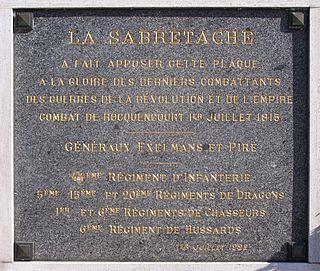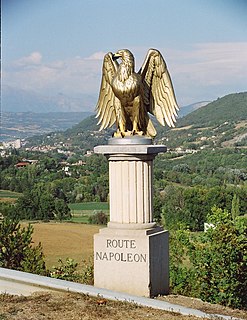 W
WAfter his defeat at the Battle of Waterloo, instead of remaining in the field with his shattered army Napoleon returned to Paris in the hope of retaining political support for his position as Emperor of the French. With his political base secured he hoped to then be able to continue the war. It was not to be; instead the members of the two chambers created a Provisional Government and demanded that Napoleon abdicate. Napoleon toyed with the idea of a coup d'état similar to Eighteenth of Brumaire but decided against it. On 25 June Napoleon left Paris for the final time and after staying at the Palace of Malmaison, left for the coast hoping to reach the United States of America. In the meantime, the Provisional Government deposed his son and tried to negotiate a conditional surrender with the Coalition powers. They failed to obtain any significant concessions from the Coalition who insisted on a military surrender and the restoration of Louis XVIII. Napoleon, realising he could not hope to evade the Royal Navy, surrendered to Captain Maitland upon placing himself under his protection on board HMS Bellerophon. The British Government refused to allow Napoleon to set foot in England and arranged for his exile to the remote South Atlantic island of Saint Helena where he died in 1821.
 W
WThe Battle of Rocheserviere was fought at Rocheservière on the 20 June 1815, between Vendéan Royalists, who had remained loyal to King Louis XVIII during the Hundred Days, and Napoleon's Army of the West, commanded by General Jean Maximilien Lamarque. The battle ended with the defeat of the Royalist forces. Five days later the Treaty of Cholet was signed, ending the hostilities.
 W
WThe Battle of Rocquencourt was a cavalry skirmish fought on 1 July 1815 in and around the villages of Rocquencourt and Le Chesnay. French dragoons supported by infantry and commanded by General Exelmans destroyed a Prussian brigade of hussars under the command of Lieutenant Colonel Eston von Sohr.
 W
WThe Chambre introuvable was the first Chamber of Deputies elected after the Second Bourbon Restoration in 1815. It was dominated by Ultra-royalists who completely refused to accept the results of the French Revolution. The name was coined by King Louis XVIII of France.
 W
WChassigny is a Mars meteorite which fell on October 3, 1815, at approximately 8:00 am, in Chassigny, Haute-Marne, France. Chassigny is the meteorite for which the chassignites are named, and gives rise to the "C" in SNCs. Chassigny is an olivine cumulate rock (dunite). It consists almost entirely of olivine with intercumulous pyroxene, feldspar, and oxides. Chassigny was the only known chassignite until NWA2737 was found in the Moroccan Sahara in northwest Africa.
 W
WThe First Restoration was a period in French history that saw the return of the Bourbon dynasty to the throne, between the abdication of Napoleon I in the spring of 1814 and the Hundred Days, in March 1815. The regime was born following the victory of the Sixth Coalition as part of the campaign of France, while the country was in conflict during the First Empire. While the Allied powers were divided over the person to be placed on the throne of France, a subtle game was established between the Bourbons in exile, the French institutions and the foreign powers, before the abdication of Napoleon I on the 6th of April opened the way to Louis XVIII, brother of Louis XVI, who returned to Paris at the end of the month and moved to the palace of the Tuileries.
 W
WThe Hundred Days War, also known as the War of the Seventh Coalition, marked the period between Napoleon's return from exile on the island of Elba to Paris on 20 March 1815 and the second restoration of King Louis XVIII on 8 July 1815. This period saw the War of the Seventh Coalition, and includes the Waterloo Campaign, the Neapolitan War as well as several other minor campaigns. The phrase les Cent Jours was first used by the prefect of Paris, Gaspard, comte de Chabrol, in his speech welcoming the king back to Paris on 8 July.
 W
WFrench legislative elections were held from 8 May to 24 August for the first legislature of the Bourbon Restoration.
 W
WThe Battle of Ligny was fought on 16 June 1815, in which French troops of the Armée du Nord under the command of Napoleon I defeated part of a Prussian army under Field Marshal Blücher, near Ligny in present-day Belgium. The battle resulted in a tactical victory for the French, but the bulk of the Prussian army survived the battle in good order and played a pivotal role two days later at the Battle of Waterloo, having been reinforced by Prussian troops who had not participated at Ligny. The battle of Ligny was the last victory in Napoleon's military career.
 W
WDuring the Hundred Days of 1815, both the Coalition nations and the First French Empire of Napoleon Bonaparte mobilised for war. This article describes the deployment of forces in early June 1815 just before the start of the Waterloo Campaign and the minor campaigns of 1815.
 W
WOn 1 March 1815 Napoleon Bonaparte escaped from his imprisonment on the isle of Elba, and launched a bid to recover his empire. A confederation of European powers pledged to stop him. During the period known as the Hundred Days Napoleon chose to confront the armies of Prince Blücher and the Duke of Wellington in what has become known as the Waterloo Campaign. He was decisively defeated by the two allied armies at the Battle of Waterloo, which then marched on Paris forcing Napoleon to abdicate for the second time. However Russia, Austria and some of the minor German states also fielded armies against him and all of them also invaded France. Of these other armies the ones engaged in the largest campaigns and saw the most fighting were two Austrian armies: The Army of the Upper Rhine and the Army of Italy.
 W
WThe Treaty of Paris of 1815 was signed on 20 November 1815 following the defeat and second abdication of Napoleon Bonaparte. In February, Napoleon had escaped from his exile on Elba; he entered Paris on 20 March, beginning the Hundred Days of his restored rule. After France's defeat at the hands of the British and the Prussians in the Battle of Waterloo, Napoleon was persuaded to abdicate again, on 22 June. King Louis XVIII, who had fled the country when Napoleon arrived in Paris, took the throne for a second time on 8 July.
 W
WThe Battle of Quatre Bras was fought on 16 June 1815, as a preliminary engagement to the decisive Battle of Waterloo that occurred two days later. The battle took place near the strategic crossroads of Quatre Bras and was contested between elements of the Duke of Wellington's Anglo-allied army and the left wing of Napoleon Bonaparte's French Armée du Nord under Marshal Michel Ney. While the battle was tactically indecisive, Napoleon achieved his larger strategic aim of preventing Wellington's forces from aiding the Prussian army at the Battle of Ligny, which the French won the same day.
 W
WAfter the defeat of Napoleon at the Battle of Waterloo and the advance on Paris by the Coalition armies during the months of June and July 1815, although they besieged and took some towns and fortresses as they advance, they bypassed many of them and detached forces to observe and reduce them. The last of the French fortresses did not capitulate until September of that year.
 W
WThe Route Napoléon is the route taken by Napoléon in 1815 on his return from Elba. It is now concurrent with sections of routes N85, D1085, D4085, and D6085.
 W
WThe Waterloo Campaign was fought between the French Army of the North and two Seventh Coalition armies, an Anglo-allied army and a Prussian army. Initially the French army was commanded by Napoleon Bonaparte, but he left for Paris after the French defeat at the Battle of Waterloo. Command then rested on Marshals Soult and Grouchy, who were in turn replaced by Marshal Davout, who took command at the request of the French Provisional Government. The Anglo-allied army was commanded by the Duke of Wellington and the Prussian army by Prince Blücher.
 W
WThe Waterloo campaign commenced with a pre-emptive attack by the French Army of the North under the command of Napoleon Bonaparte. The first elements of the Army of the North moved from their peacetime depots on 8 June to their rendezvous point just on the French side of the Franco-Belgian border. They launched a pre-emptive attack on the two Coalition armies that were cantoned in Belgium—the Anglo-allied army under the command of the Duke of Wellington, and a Prussian army under the command of Prince Blücher.
 W
WAfter their defeat at the Battle of Ligny the Prussians successfully disengaged and withdrew to north to Wavre where they reorganised and then three corps advanced westward to attack the right flank of the French army at the Battle of Waterloo. The French were desultory in the aftermath of Ligny. Napoleon wasted the morning of 17 June by taking a late breakfast and going to see the previous day's battlefield before organising a pursuit of the two Coalition armies. He took the reserves and marched with Marshal Ney in pursuit of the Duke of Wellington's Anglo-allied army, and he gave instructions to Marshal Grouchy to pursue the Prussians wherever they were going and harry them so that they had no time to reorganise.
 W
WAfter the fighting at Quatre Bras the two opposing commanders Marshal Ney and the Duke of Wellington initially held their ground while they obtained information about what had happened at the larger Battle of Ligny. They received intelligence that the Prussian army under the command of Prince Blücher had been defeated by the French Army of the North under the command of Napoleon Bonaparte.
 W
WAfter their defeat at the Battle of Waterloo on 18 June 1815, the French Army of the North, under the command of Napoleon Bonaparte retreated in disarray back towards France. As agreed by the two Seventh Coalition commanders in chief, the Duke of Wellington, commander of the Anglo-allied army, and Prince Blücher, commander of the Prussian army, the French were to be closely pursued by units of the Prussian army.
 W
WAfter their defeat at the Battle of Waterloo on 18 June 1815, the French Army of the North, under the command of Napoleon Bonaparte retreated in disarray back towards France. As agreed by the two Seventh Coalition commanders in chief, the Duke of Wellington, commander of the Anglo-allied army, and Prince Blücher, commander of the Prussian army, the French were to be closely pursued by units of the Prussian army.
 W
WAfter their defeat at the Battle of Waterloo on 18 June 1815, the French Army of the North, under the command of Napoleon Bonaparte retreated in disarray back towards France. As agreed by the two Seventh Coalition commanders in chief, the Duke of Wellington, commander of the Anglo-allied army, and Prince Blücher, commander of the Prussian army, the French were to be closely pursued by units of the Prussian army.
 W
WThe Battle of Wavre was the final major military action of the Hundred Days campaign and the Napoleonic Wars. It was fought on 18–19 June 1815 between the Prussian rearguard, consisting of the Prussian III Corps under the command of General Johann von Thielmann and three corps of the French army under the command of Marshal Grouchy. A blocking action, this battle kept 33,000 French soldiers from reaching the Battle of Waterloo and so helped in the defeat of Napoleon at Waterloo.